RYAN TERRY: SUREFIRE SIX-PACK!
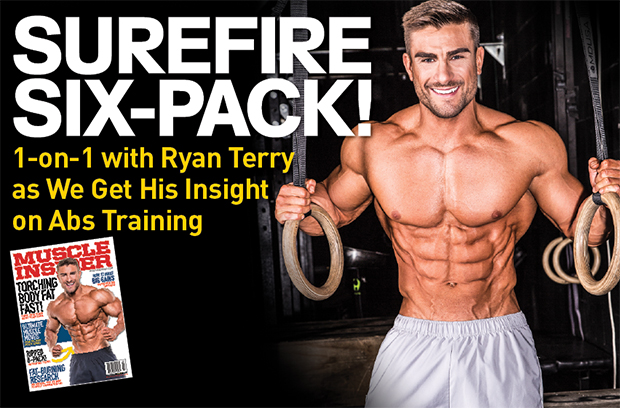
1-on-1 with MUSCLE INSIDER Cover Model and 2017 Arnold Classic Men’s Physique Champion Ryan Terry as We Get His Insight on Abs Training
If you do a Google search for “Ryan Terry,” one of the top six articles that show up on the first page is “How a skinny plumber became the fittest man in the UK.” To say that Ryan came from humble beginnings is akin to saying that bodybuilders are somewhat hungry on a diet—a gross understatement. Here’s a guy who only got into lifting in the first place because he tore his Achilles tendon when he was 14 and gained weight from inactivity. There’s no glamorous story or famous father whose footsteps he’s following in. He carved out his own niche first as a fitness model (winning Mr. Great Britain in 2010), and only later, in 2013 when he won the Arnold Amateurs in Madrid, did he get the IFBB Pro title.
Ryan’s still young (only 29 years old), and still a rookie in the sport. But in the meantime, it seems like he has the world at his feet. We caught up with him to find out what he’s been up to since the Arnold, how his Olympia placing affected him, what his plans for the off-season are, and how, why, and what he does to stay so unbelievably shredded all the time!
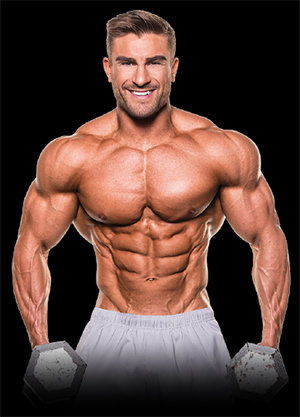 MUSCLE INSIDER: You went from first place at the 2017 Arnold Sports Festival down to sixth at the Olympia that same year, then back up to first at the Asia Grand Prix one week later! What happened in the time frame between these shows, and how did this affect you?
MUSCLE INSIDER: You went from first place at the 2017 Arnold Sports Festival down to sixth at the Olympia that same year, then back up to first at the Asia Grand Prix one week later! What happened in the time frame between these shows, and how did this affect you?
RYAN TERRY: Little knocks in life hit me quite hard because of my past, and this year was a roller coaster. At the start of the year, I reached my ultimate dream: winning the Arnold Classic and meeting my idol, Arnold himself. That was a great confidence builder for me, and it was the first time in my career that I felt I had a chance to win the Olympia. But coming in sixth hit me like a ton of bricks because I honestly thought I had a shot at winning the O. Every other year, I had just been grateful for the experience. I thought I’d done everything possible to achieve that goal: I moved to America, I forced my physique to be bigger (even though I prefer to look very conditioned over having more size), and it didn’t work. It had knocked my confidence back ever since, but it’s something I’ve been utilizing to motivate me to try even harder.
For the Olympia, I tried to get bigger because I thought that’s what the judges wanted. I focused on what other people were saying on social media, instead of just doing what I’m used to. When I competed one week after the Olympia in Seoul Korea at the Asia Grand Prix, I did what I was comfortable with: depleted right down, didn’t carb up, and just came in super-shredded and smaller. And the judges preferred that. They even said that was what they’d wanted to see at the Olympia!
 MI: We see the photos you post on Instagram and you’ve always kept yourself in ridiculous shape and season. What was the strategy here?
MI: We see the photos you post on Instagram and you’ve always kept yourself in ridiculous shape and season. What was the strategy here?
RT: I don’t see eating clean or being on a diet as a chore. So over the years, because I’ve stayed so clean and lean for so long, my metabolism is crazy. It allows me to stay in great conditioning year round. But that’s not helping me anymore, so I decided that I’m going to skip the Arnold in 2018. I want to give my body a rest. For the past five or six years, I’ve constantly competed at the beginning and the end of the year, so I diet practically all year with only maybe three months off mid-year between shows. I love it and want to compete all year, but it’s really tough on your body. I need to be bigger for the Olympia, so it would just be too hard to force myself to grow in only three months between now and dieting for the Arnold.
MI: Does your weight change much in the off-season?
RT: It fluctuates. Onstage, I weigh between 195 and 198 pounds, and then offstage, my weight is around 205 pounds and I struggle to get past that weight. It’s not a great increase, but I’m determined to get my weight higher this off-season.
MI: How does your cardio and nutrition change from off-season to on-season when you’re cutting?
RT: Having such a fast metabolism and such a hard time gaining weight means that I have to start relaxing on my diet a bit more and slow my metabolism down. Calories are bumped right up, and I introduce “normal” food in between my clean meals. We’re talking 4000 to 4500 and upwards. 2800 to 3000 is the lowest I’ll ever go when I diet, so I start my off-season around 4000 calories. When I diet, I count every macro and calorie, and then slowly decrease over 12 weeks. In my off-season, I want to be able to switch off, and just enjoy the food. I try to make sure I’m getting 200 grams of protein per day, around 450 grams of carbs, and above 70 grams of fat.
When I diet, I do 60 minutes of cardio in the morning, fasted. My body doesn’t react to the way it used to when I was younger, so I’ve had to start doing more to get lean. Taking it out will make it easier to diet once I need to start again.
MI: What about training?
RT: My training won’t change that much, honestly, because it’s already very sporadic. I also try to swap up my exercises, rep ranges, and tempo because I never have set plans. I just like feeling my strength and my body as I go. If I’m feeling strong, then I’ll go heavy. Or if I’m feeling lethargic, I’ll focus on the mind-muscle and do less weight. It will always change either way, but I’ll also give myself more rest between sets and give myself a complete rest day as well. When I prep, I always have an active rest, so I’ll be away from the gym, but still do something very active.
MI: In terms of supplements, will you take more (or less) of anything during your off-season versus on-season?
RT: I usually double up my carb powder consumption in the off-season, and only keep it to one serving on-season. I have 50 grams before I train, 50 while I train, and 100 after, whereas on-season, I only do 20/20/50. Also in the off-season, I would take something after training that has creatine, a test booster, and more calories—essentially a fast-grow anabolic protein powder, instead of a whey isolate. I take out the lean muscle gainer when I diet, but the BCAAs stay the same. I take those year-round, pre- and during my workout. My supplements are always around my training.
 MI: When it comes time to diet, do you work like a light switch or a dimmer? Are you all-or-nothing on/off, or do you need a little bit of time to transition?
MI: When it comes time to diet, do you work like a light switch or a dimmer? Are you all-or-nothing on/off, or do you need a little bit of time to transition?
RT: I’m definitely that dimmer. Especially putting on weight, because that’s not something I’m particularly comfortable with. I naturally enjoy dieting, so when I’m out of my comfort zone, it’s hard to adjust physically and mentally. When you see your body start to soften up, it’s pretty hard to deal with.
MI: How often do you cheat/refeed? Do you think it’s necessary?
RT: When I’m dieting, I have refeeds days, and it all depends on how fast or slow I’m coming in. Each prep is different. On average, I have about two to four refeeds in a 12-week period. It’s never more than four and never less than two. For the Olympia, it was three big refeeds in order to help me stay fuller and bigger.
MI: Would you ever consider competing in the Classic Physique division?
RT: To be honest, I would absolutely love to. I’ve been following bodybuilding since I was 14, and have always respected them. I’m also really proud of my leg development and I hate having to cover them up competing in Men’s Physique! But I’m realistic about the fact that it would take my physique a lot of time to get there. There’s an announcement that they’re adding another five pounds to each weight class in Classic Physique, and I’m already on the smaller side for some of the guys in Men’s Physique. So that extra five pounds would just make it even harder for me to compete.
 MI: How many days a week do you train abs?
MI: How many days a week do you train abs?
RT: I train abs twice a week, and give them three to four days rest in between. I treat them like any other muscle part, whereas instead of just tacking on a couple of exercises at the end of another big body part, I actually give them at least 30 to 40 minutes of direct training.
MI: How many reps/sets/exercises do you do in those 30 to 40 minutes training abs?
RT: It all depends on my game plan for that week, depending on whether I’m going heavy or light that week. As an example, the first workout will be upper and lower abs, and I’ll go heavy, then I’ll do some lighter stuff for obliques. And then for the second session in the week, I may just do bodyweight stuff for core, and then do weighted exercises for obliques.

RYAN TERRY ABS TIPS
1. Crunches
Because this isn’t weighted, you want to focus on the mind-muscle connection. Focus on the contraction. Exhale all your air out once you get to the top of the movement. I do 2 seconds up, 1 second hold, then 2 seconds down. If you really want to challenge yourself, do 2-1-4.
2. Reverse crunches
Again, this is about keeping control throughout the whole exercises, so don’t worry about how many reps you do. Just focus on the quality, the tempo, and your breathing. Make it harder by slowing the movement down—e.g., 4 seconds down.
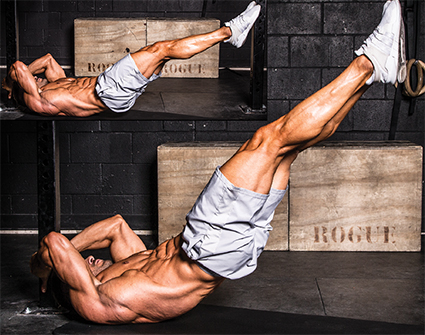
3. Hanging leg raises
One of my favourite exercises for getting results, but definitely not the most enjoyable. I start my workouts with these because they hit every part of the core. You get a nice V (that cut at the bottom), upper and lower abs, your obliques, and also your lower back and transverse abdominus when you control the movement and keep everything tight. I’ll do 3 sets to failure, and it always wrecks me.
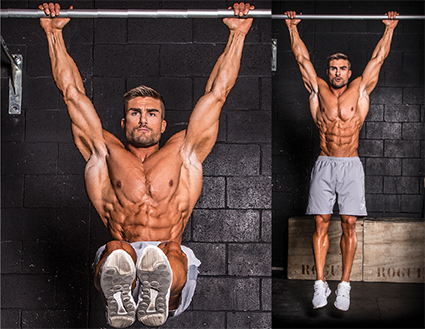
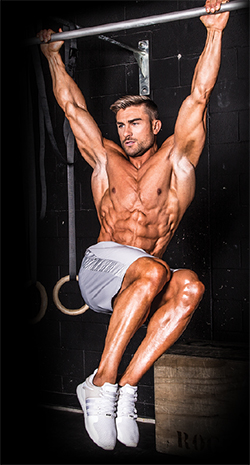 4. Twists
4. Twists
This is isolated to your obliques, so start with your weaker side, and do all the reps on that side first. Then just match the reps on your strong side. This isn’t usually something people think about.

5. Static holds on rings/plank
This is a great one for strengthening your whole core. It’s something I’d use as a finisher because you can just use your own body weight. It’s about contracting literally everything from your abdominals, to your obliques, and even your glutes. Everything has to be engaged.

